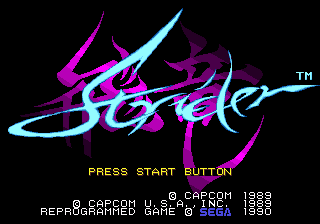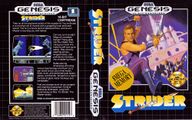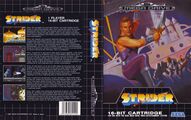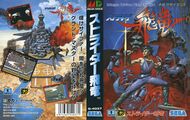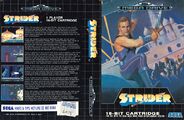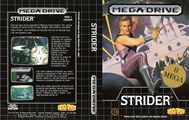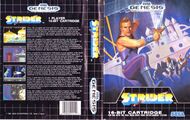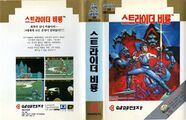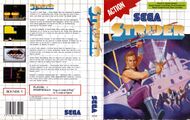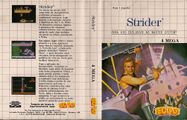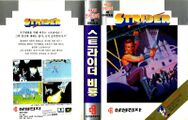Strider
From Sega Retro
This short article is in need of work. You can help Sega Retro by adding to it.
| Strider | ||||||||||||||||||||||||||||||||||||||||
|---|---|---|---|---|---|---|---|---|---|---|---|---|---|---|---|---|---|---|---|---|---|---|---|---|---|---|---|---|---|---|---|---|---|---|---|---|---|---|---|---|
| System(s): Sega Mega Drive, Sega Master System, Virtual Console | ||||||||||||||||||||||||||||||||||||||||
| Publisher: Sega | ||||||||||||||||||||||||||||||||||||||||
| Developer: Sega | ||||||||||||||||||||||||||||||||||||||||
| Developer(s) of original games: Capcom | ||||||||||||||||||||||||||||||||||||||||
| Genre: Action | ||||||||||||||||||||||||||||||||||||||||
| Number of players: 1 | ||||||||||||||||||||||||||||||||||||||||
| ||||||||||||||||||||||||||||||||||||||||
|
CERO
Missing Parameter! |
Strider, known as Strider Hiryuu (ストライダー飛竜) in Japan, is an action game developed by Capcom and released for CPS arcade hardware in 1989. It was subsequently brought to home consoles and computers, including the Sega Mega Drive and Sega Master System.
Contents
Gameplay
Strider is an action-platformer. The highly mobile protagonist needs to can walk, run, slide and climb to conquer all five stages and defeat the self proclaimed world ruler, grandmaster. Aside from his sword, Strider can also employ robotic helpers (one of them resembling a tiger) to fight his adversaries.
Versions
The Sega versions of Strider were licensed from Capcom, but developed internally at Sega. Allegedly Sega was not given much support by Capcom, forcing the teams to rip graphics and reverse engineer arcade units to create both games (it is rumoured that practise was also in effect for Ghouls'n Ghosts and Final Fight CD, Capcom not partaking in Sega development on their own until Street Fighter II: Special Champion Edition).
Mega Drive
Strider was brought to the Sega Mega Drive relatively early in the system's lifespan, debuting in late 1990. It was seen as one of the hard hitting 16-bit action games designed to encourage users to migrate from Nintendo's NES to Sega's console, boasting high definition graphics and recorded speech samples. It was the first 1MB (8Mb) ROM cartridge released for the system, making it one of the largest cartridge-based video games available at the time.
The comparison between Mega Drive and NES is striking when discussing Strider, as despite having a hand in both developing and publishing the Nintendo version, the console's technical restrictions led to an entirely different game. Meanwhile the Mega Drive version was for a while the most accurate home arcade conversion available to consumers (inevitably superseded by a Sharp X68000 version in November 1992).
The most noticeable differences in the Mega Drive version are the slower attack speed (especially when hanging from the ceiling) and lower acceleration (meaning the jungle stage and final stage's inverse gravity section require different approaches to that of the arcade). Like its arcade counterpart, the western versions lacks Hiryu's "Ha!" shout while attacking with the sword.
There are also slight differences between regions; when playing up to the boss rush section of the final stage without losing a life in the Japanese Sega Mega Drive version, there is a high chance that Ouroboros (stage one boss), normally transporting the player to the place of the final battle, will not appear. The player has to deliberately lose a life to respawn Ouroboros. This issue was apparently fixed in the Western versions. Continues may be used in the Western versions whereas the Japanese release requires the player to input a cheat code to enable them, and the famous line, "All sons of old gods, die!", spoken by the final boss, was removed from the Western versions.
Strider is one of the few Sega Mega Drive games that has noticeable load times during stages. The game stops for about half a second when new background graphics or big enemies, like boss characters, appear. It also features an original ending scene.
Master System
Unlike its NES counterpart, the Master System Strider is a compacted version of the arcade game, with simpler graphics and sound as is to be expected of the console. It is known, however, to suffer from heavy slowdown when the engine is under stress, so much so that simply attacking will cause the frame rate to drop.
History
Legacy
Multiple other versions of Strider exist, all of which (bar the aforementioned X68000 version) are widely considered to be less accurate than the Mega Drive version. Ports were made to the Amiga, Amstrad CPC, Atari ST, Commodore 64, DOS and ZX Spectrum. A PC Engine Arcade CD-ROM², version, exclusive to Japan and released in September 1994 could be considered the Mega Drive's closest rival, but still falls short due to a number of graphical omissions (in exchange for an extra level).
Strider was unofficially followed by U.S. Gold's Strider II, however Capcom later returned in 1999 to make a true sequel under the name of Strider 2. The character of Strider Hiryuu has also appeared in other Capcom games, such as 1999's Marvel vs. Capcom: Clash of Super Heroes, released among other systems for the Sega Dreamcast.
The Mega Drive version was also made available for the Wii's Virtual Console service in 2011.
Production credits
Mega Drive version
- Chief Programmer / Program Coordinator: Yama1
- Assistant Programmer: Mizoran
- Chief Designer / Graphic Coordinator: Taro.S☻
- Designer: Sayshi, Mt.Maya
- Sound Programmer: XOR
- Total Coordinator: Pal‑Ko♥
- Special Thanks to: Momonga Momo, Little Sun, Larie, Thunder, Panpakapann, Filly, The Hi Master, Capcom Arcade Staff
Magazine articles
- Main article: Strider/Magazine articles.
Promotional material
Mega Drive JP TV advert
also published in:
also published in:
- Ação Games (BR) #8: "Dezembro 1991" (199x-12-xx)[4]
- Supergame (BR) #5: "Dezembro 1991" (1991-12-xx)[5]
Physical scans
Mega Drive version
| 86 | |
|---|---|
| Based on 36 reviews | |
Master System version
| Sega Retro Average | ||||||||||||||||||||||||||||||||||||||||||||||||||||||||||||||||||||||||||||||||||||||||||||||||||||||||
|---|---|---|---|---|---|---|---|---|---|---|---|---|---|---|---|---|---|---|---|---|---|---|---|---|---|---|---|---|---|---|---|---|---|---|---|---|---|---|---|---|---|---|---|---|---|---|---|---|---|---|---|---|---|---|---|---|---|---|---|---|---|---|---|---|---|---|---|---|---|---|---|---|---|---|---|---|---|---|---|---|---|---|---|---|---|---|---|---|---|---|---|---|---|---|---|---|---|---|---|---|---|---|---|---|
|
| 69 | |
|---|---|
| Based on 20 reviews | |
| Master System, AU |
|---|
|
External links
References
NEC Retro has more information related to Strider Hiryuu
|
- ↑ 1.0 1.1 1.2 File:AcaoGames BR 005.pdf, page 26 Cite error: Invalid
<ref>tag; name ":File:AcaoGames BR 005.pdf_p26" defined multiple times with different content - ↑ GamePro, "December 1990" (US; 1990-xx-xx), page 126
- ↑ GamePro, "March 1991" (US; 1991-xx-xx), page 72
- ↑ Ação Games, "Dezembro 1991" (BR; 199x-12-xx), page 49
- ↑ Supergame, "Dezembro 1991" (BR; 1991-12-xx), page 5
- ↑ 6.0 6.1 File:ACE UK 40.pdf, page 103 Cite error: Invalid
<ref>tag; name ":File:ACE UK 40.pdf_p103" defined multiple times with different content - ↑ 7.0 7.1 File:AcaoGames BR 005.pdf, page 22 Cite error: Invalid
<ref>tag; name ":File:AcaoGames BR 005.pdf_p22" defined multiple times with different content - ↑ 8.0 8.1 File:CGtC UK 04.pdf, page 36 Cite error: Invalid
<ref>tag; name ":File:CGtC UK 04.pdf_p36" defined multiple times with different content - ↑ File:CVG UK 109.pdf, page 68
- ↑ File:CVG IT 01.pdf, page 30
- ↑ 11.0 11.1 File:EGM US 016.pdf, page 20 Cite error: Invalid
<ref>tag; name ":File:EGM US 016.pdf_p20" defined multiple times with different content - ↑ 12.0 12.1 Mean Machines: The Essential Sega Guide, Virgin Books, page 98 Cite error: Invalid
<ref>tag; name ":File:MeanMachinesEssentialSegaGuide Book UK.pdf_p98" defined multiple times with different content - ↑ File:GamePro US 0017.pdf, page 124
- ↑ 14.0 14.1 File:HobbyConsolas ES 006.pdf, page 90 Cite error: Invalid
<ref>tag; name ":File:HobbyConsolas ES 006.pdf_p90" defined multiple times with different content - ↑ 15.0 15.1 File:Joystick FR 010.pdf, page 108 Cite error: Invalid
<ref>tag; name ":File:Joystick FR 010.pdf_p108" defined multiple times with different content - ↑ 16.0 16.1 File:MegaTech UK 01.pdf, page 80 Cite error: Invalid
<ref>tag; name ":File:MegaTech UK 01.pdf_p80" defined multiple times with different content - ↑ 17.0 17.1 File:MeanMachines UK 02.pdf, page 18 Cite error: Invalid
<ref>tag; name ":File:MeanMachines UK 02.pdf_p18" defined multiple times with different content - ↑ 18.0 18.1 File:PlayerOne FR 007.pdf, page 26 Cite error: Invalid
<ref>tag; name ":File:PlayerOne FR 007.pdf_p26" defined multiple times with different content - ↑ 19.0 19.1 File:Raze UK 04.pdf, page 15 Cite error: Invalid
<ref>tag; name ":File:Raze UK 04.pdf_p15" defined multiple times with different content - ↑ 20.0 20.1 File:Raze UK 08.pdf, page 24 Cite error: Invalid
<ref>tag; name ":File:Raze UK 08.pdf_p24" defined multiple times with different content - ↑ 21.0 21.1 File:SegaPro UK 06.pdf, page 29 Cite error: Invalid
<ref>tag; name ":File:SegaPro UK 06.pdf_p29" defined multiple times with different content - ↑ 22.0 22.1 File:SegaForce SE 1992 02.pdf, page 21 Cite error: Invalid
<ref>tag; name ":File:SegaForce SE 1992 02.pdf_p21" defined multiple times with different content - ↑ 1700 igr dlya Sega, "" (RU; 2001-xx-xx), page 227
- ↑ Buzz! Computers (UK) (+0:00)
- ↑ The Complete Guide to Sega, "" (UK; 1991-05-xx), page 49
- ↑ Console XS, "June/July 1992" (UK; 1992-04-23), page 134
- ↑ Computer & Video Games, "December 1990" (UK; 1990-11-16), page 30
- ↑ Famitsu, "" (JP; 1990-xx-xx), page 1
- ↑ GamePro, "December 1990" (US; 1990-xx-xx), page 124
- ↑ Sega Mega Drive Advanced Gaming, "January 1993" (UK; 199x-xx-xx), page 94
- ↑ Mega Drive Fan, "December 1990" (JP; 1990-11-08), page 79
- ↑ Mega, "June 1993" (UK; 1993-05-20), page 21
- ↑ Mega Action, "June 1993" (UK; 1993-05-20), page 65
- ↑ Mega Play, "February 1991" (US; 199x-xx-xx), page 43
- ↑ Mean Machines Sega, "October 1992" (UK; 1992-09-xx), page 142
- ↑ Power Play, "12/90" (DE; 1990-11-16), page 156
- ↑ Sega Power, "June 1991" (UK; 1991-05-02), page 10
- ↑ Sega Power, "October 1991" (UK; 1991-09-05), page 54
- ↑ Sega Pro, "April 1993" (UK; 1993-03-11), page 67
- ↑ Sega Saturn Magazine, "September 1995" (JP; 1995-08-08), page 86
- ↑ Tricks 16 bit, "Tricks Sega Gold 800 igr" (RU; 1998-03-20), page 188
- ↑ User, "Ioúnios 1991" (GR; 1991-0x-xx), page 66
- ↑ VideoGames & Computer Entertainment, "January 1991" (US; 199x-xx-xx), page 54
- ↑ Video Games, "1/91" (DE; 1991-03-27), page 83
- ↑ 45.0 45.1 Mean Machines: The Essential Sega Guide, Virgin Books, page 158 Cite error: Invalid
<ref>tag; name ":File:MeanMachinesEssentialSegaGuide Book UK.pdf_p158" defined multiple times with different content - ↑ 46.0 46.1 File:HobbyConsolas ES 002.pdf, page 26 Cite error: Invalid
<ref>tag; name ":File:HobbyConsolas ES 002.pdf_p26" defined multiple times with different content - ↑ 47.0 47.1 File:Joystick FR 021.pdf, page 169 Cite error: Invalid
<ref>tag; name ":File:Joystick FR 021.pdf_p169" defined multiple times with different content - ↑ File:MeanMachines UK 06.pdf, page 62
- ↑ 49.0 49.1 File:PlayerOne FR 014.pdf, page 70 Cite error: Invalid
<ref>tag; name ":File:PlayerOne FR 014.pdf_p70" defined multiple times with different content - ↑ 50.0 50.1 File:SegaForce UK 01.pdf, page 60 Cite error: Invalid
<ref>tag; name ":File:SegaForce UK 01.pdf_p60" defined multiple times with different content - ↑ 51.0 51.1 File:SegaForce UK 18.pdf, page 74 Cite error: Invalid
<ref>tag; name ":File:SegaForce UK 18.pdf_p74" defined multiple times with different content - ↑ Aktueller Software Markt, "Februar 1992" (DE; 1992-01-10), page 128
- ↑ Console XS, "June/July 1992" (UK; 1992-04-23), page 145
- ↑ FX (UK) (+0:00)
- ↑ GamePro, "June 1991" (US; 1991-xx-xx), page 50
- ↑ Games-X, "10th-16th October 1991" (UK; 1991-10-10), page 32
- ↑ Joypad, "Novembre 1991" (FR; 1991-10-1x), page 102
- ↑ Mega Play, "May/June 1991" (US; 1991-0x-xx), page 42
- ↑ Mean Machines, "March 1991" (UK; 1991-03-01), page 50
- ↑ Mean Machines Sega, "October 1992" (UK; 1992-09-xx), page 136
- ↑ Sega Power, "January 1992" (UK; 1991-12-05), page 24
- ↑ Sega Pro, "April 1993" (UK; 1993-03-11), page 72
- ↑ User, "Fevrouários 1993" (GR; 1993-0x-xx), page 57
- ↑ Video Games, "3/91" (DE; 1991-09-06), page 77
- Pages with reference errors
- Stubs
- 1 player games
- EU Master System games
- All EU games
- AU Master System games
- All AU games
- BR Master System games
- All BR games
- KR Master System games
- All KR games
- Master System games
- 1991 Master System games
- All 1991 games
- Master System action games
- All action games
- JP Wii Virtual Console games
- All JP games
- US Wii Virtual Console games
- All US games
- EU Wii Virtual Console games
- Wii games
- 2011 Wii games
- All 2011 games
- Wii Virtual Console games
- Old content rating field
- Use romtable template
- All games
- Credits without source
- Credits without reference
- Creditstable with no console field
- GalleryPrintAd file defined
- Old-style rating (ace)
- Use magref
- Old-style rating (ag)
- Old-style rating (cgtc)
- Old-style rating (cvg)
- Old-style rating (cvgit)
- Old-style rating (egm)
- Old-style rating (esg)
- Old-style rating (gamepro)
- Old-style rating (gamesmachine)
- Rating without PDF source
- Old-style rating (hobbyconsolas)
- Old-style rating (joystick)
- Old-style rating (mdag)
- Old-style rating (mega)
- Old-style rating (megaaction)
- Old-style rating (megatech)
- Old-style rating (mm)
- Old-style rating (playerone)
- Old-style rating (raze)
- Old-style rating (segapower)
- Old-style rating (segapro)
- Old-style rating (sfsw)
- Update ratings template
- 24 old ratings
- Old-style rating (consolesplus)
- Old-style rating (gamesx)
- Old-style rating (sfuk)
- 11 old ratings
